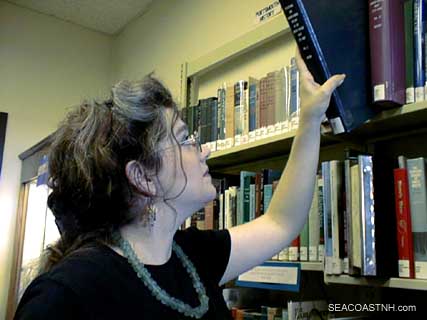|
FRESH STUFF DAILY |
|
|
||
|
|
||
|
|
||
|
SEE ALL SIGNED BOOKS by J. Dennis Robinson click here |
||
Page 2 of 3
So we must factor another name into the possible street derivation. Ichabod Bartlett was an early Portsmouth lawyer and NH congressman with plenty of political clout. He was a member of just about every man’s social club in town and helped found the Portsmouth Athenaeum. Then there was NH Governor John Henry Bartlett who taught school for four years in Portsmouth. There used to be a Bartlett School on School Street, which is now a parking lot. Governor Bartlett wrote a history of New Hampshire and authored a series of popular tales of local characters called "Folks is Folks." Could Bartlett Street be named for him? Help! I was spinning deeper into the rabbit hole, so I called for backup. Nicole Luongo Cloutier runs the History Room at the Portsmouth Public Library. There is no simple, central document, Nicole told me back then, that explains WHY Portsmouth streets got their names. Nicole’s instinct was to check the old city directories to learn when Bartlett Street was named. These are handy tools for historians. The first city directory was written by Wybird Penhallow in 1821. (There is a Wybird Street and a Penhallow Street in Portsmouth - wonder why?) A city directory is a sort of phone book before phone numbers existed. It lists streets and every business on the street by number. It lists the people in town and their occupations. By 1834 we see ads creeping in, slowly filling the pages of city directories, in a time long long before Verizon sales representatives. The ads can be as revealing as the statistics. Nicole discovered that there was a Barlett Street listed in 1864, then no Bartlett Street listed for years, then a new permanent listing starting in 1877. Drat, two Bartlett Streets. The only good news was that we could eliminate John H. Bartlett as a contender. He was too young and didn't become governor until 1901 long after the street was named. Local historians, in my view, have a weak track record for truth. We find bits and pieces, make assumptions, but we're looking at the tip of a mighty big iceberg. As with doctors, lawyers, economists and other fortune tellers, the trick is to act like you know more than you do. Toss a few facts around, then run for cover. Nicole checked the public library's archival boxes containing Portsmouth city annual reports. Those start around 1840. She checked the vertical file under "Bartlett" and 'Streets" and I rummaged through some great old articles. According to the Portsmouth Journal from 1839, for example, the city officially changed the names of about 20 major streets in one whack. It must have been terribly disorienting for the old timers. The Parade was changed to Market Square, Fore Street became Market, Ark became Penhallow, Partridge became Water (later changed to Marcy), Court became Pleasant and Pitt became Court. To make matters worse, in a tradition inherited from big cities in England, Portsmouth streets often got new names as the colonial population moved further to the outskirts of town. Daniel Street, for instance, becomes Congress (formerly King Street) when it hits Market Square, and then turns itself into Islington Street at the former library. Every Portsmouth historian from Charles Brewster and Thomas Bailey Aldrich to Bruce Ingmire and Ray Brighton have written about the street-naming chaos. Toss in the fact that many downtown streets are now one-way. And don't forget that many of the streets were renumbered back at the turn of the century. Yikes. Following the rabbit hole, I found myself in the Portsmouth Athenaeum, the city's private library that opened in 1817 across from the North Church steeple. I'm one of 300-something "proprietors" there and nobody thinks it strange when a member suddenly blurts out an obscure question. So I did. "Anyone know whom Bartlett Street is named after?" There was a bustle of activity in response. Ronan Donohoe, a history teacher and former Athenaeum president, loves these puzzles. We looked at a series of 19th century Portsmouth street maps for clues. An 1813 map shows Bartlett near what is now Rock Street. Then it disappears and reappears around the Civil War, running now from Cushing Street to Newington Road. Then it vanishes again. Today Bartlett branches off Islington at the sharp curve by the railroad bridge. It's a key route to the traffic circle from downtown. It was once lined with beautiful elms before they all died of disease in the late 1800s, leaving the street naked and urban-looking. Until around 1876, Bartlett Street was named Creek Street. The "crick" was a popular spot in colonial days for women to wash clothes. As the Italian immigrants moved in at the turn of the 20th century, old Portsmouth legend says, the Irish moved "up the Crick" to live. Then Ronan had a thought. (I call him Ronan the Librarian after Conan the Barbarian for his Schwartnegger-like power when it comes to researching.) He reminded me that the Athenaeum has a file on each of its past proprietors. Among them are many Bartletts. Ugh, more Bartletts. We looked up Ichabod Bartlett, who died in 1853. Ichabod was still a contender until Ronan dealt him a weighty blow. "Doesn't it make sense that the second Bartlett Street had something to do with the centenary of 1876? With all that patriotic fervor for 1776, somebody must have noticed that Josiah Bartlett's street had gone missing." CONTINUE WITH STREET ARTICLE Please visit these SeacoastNH.com ad partners.
News about Portsmouth from Fosters.com |
| Friday, April 26, 2024 |


|
Copyright ® 1996-2020 SeacoastNH.com. All rights reserved. Privacy Statement
Site maintained by ad-cetera graphics

 HISTORY
HISTORY



















